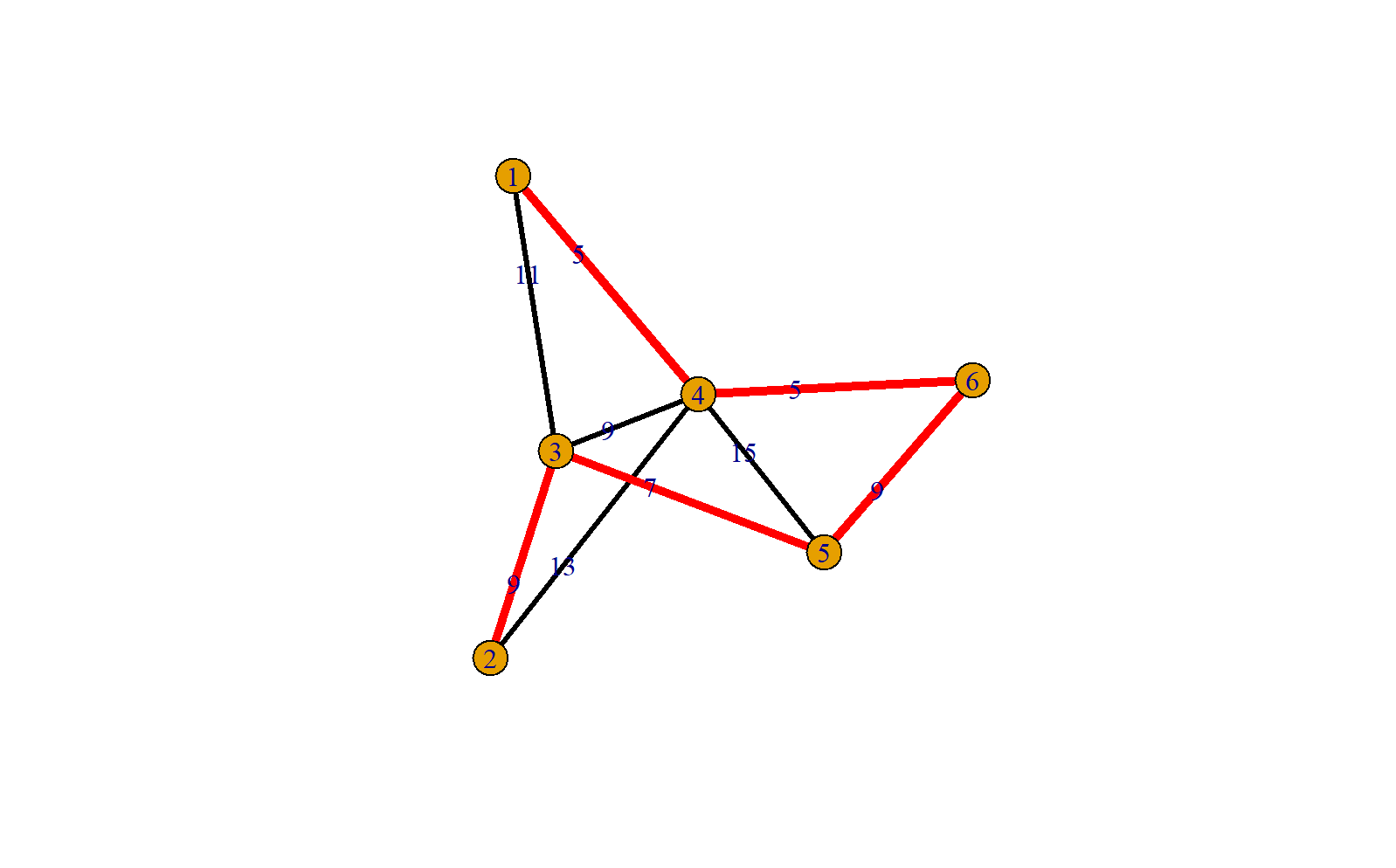图与网络分析—R和Python实现(三)
最小生成树 (Minimum Spanning Tree) 应该大家都不陌生,Spanning 有跨越的意思,生成树一般来说每个节点都能访问到别的节点,是一个连通树。所以,一般考虑无向图里去造生成树。生成树又分最小和最大两种,其中最小生成树应用比较多。
一、 最小生成树问题
生成树:一个连通图的生成树是指一个连通子图,它含有图中全部n个顶点,但只有足以构成一棵树的n-1条边。一颗有n个顶点的生成树有且仅有n-1条边,如果生成树中再添加一条边,则必定成环。
最小生成树:在连通网的所有生成树中,所有边的代价和最小的生成树,称为最小生成树。

二、 求最小生成树算法
2.1 Kruskal算法
此算法可以称为“加边法”,初始最小生成树边数为0,每迭代一次就选择一条满足条件的最小代价边,加入到最小生成树的边集合里。
- 把图中的所有边按代价从小到大排序;
- 把图中的n个顶点看成独立的n棵树组成的森林;
- 按权值从小到大选择边,所选的边连接的两个顶点ui,viui,vi,应属于两颗不同的树,则成为最小生成树的一条边,并将这两颗树合并作为一颗树。
- 重复(3),直到所有顶点都在一颗树内或者有n-1条边为止。

2.2 Prim算法
此算法可以称为“加点法”,每次迭代选择代价最小的边对应的点,加入到最小生成树中。算法从某一个顶点s开始,逐渐长大覆盖整个连通网的所有顶点。
图的所有顶点集合为VV;初始令集合u={s},v=V−uu={s},v=V−u;
在两个集合u,vu,v能够组成的边中,选择一条代价最小的边(u0,v0)(u0,v0),加入到最小生成树中,并把v0v0并入到集合u中。
重复上述步骤,直到最小生成树有n-1条边或者n个顶点为止。

三、 最小生成树R程序
library("igraph")
#赋权图的构建
A = matrix(c(0, 0, 11, 5, 0, 0,0, 0, 9, 13, 0, 0,11, 9, 0, 9, 7, 0,5, 13, 9, 0, 15, 5,0, 0, 7, 15, 0, 9,0, 0, 0, 5, 9, 0),
nrow= 6 , ncol= 6 ,byrow = TRUE)
g<- graph.adjacency(A,weighted=TRUE, mode = c("undirected"))

#最小生成树的计算
tr= minimum.spanning.tree(g,weights = graph_attr(g,'weight'))
plot(tr,layout=layout.reingold.tilford,edge.label=E(tr)$weight)

#最小树合成图
library(dplyr)
ggg=get.data.frame(g)
tr1=get.data.frame(tr)
dd1=setdiff(ggg,tr1)
dd1$color="black"
dd1$width=3
tr1$color="red"
tr1$width=5
ee=union_all(dd1,tr1)
g <- make_graph(t(ee[,1:2]),directed = FALSE)
plot(g,edge.label = ee$weight,edge.color = ee$color,edge.width=ee$width)

四、最小生成树Pyhton程序
给定一个阶简单的赋权图G,它的权函数 就决定了一个权矩阵 ,其中 ;若 ,则 ;若 ,则 。
可用权矩阵法计算最小树:
- Step0: 划掉矩阵 的第一列(即把第一列的所有元素都改为),并把第 1 行中剩下的每个元素画下划线。
- Step1: 在有下划线的元素中找一个最小的元素 。若 ,停止,G中不存在支撑树; 否则,把 圈起来,然后把第 列其他元素都改为 ,并把第 行没有划掉的元素画下划线。
- Step2: 若所有的元素或者被圈起来或者被划掉,则结束,圈起来的元素对应于最小树的边;否则转Step1。
求 的最小树的过程如下:

import sys
import networkx as nx
import matplotlib.pyplot as plt
# Number of vertices in the graph
V = 5
# Function to find the vertex with the minimum key value, from
# the set of vertices not yet included in the MST
def minKey(key, mstSet):
min = sys.maxsize
min_index = -1
# Search for the vertex not in mstSet that has the smallest key
for v in range(V):
if key[v] < min and not mstSet[v]:
min = key[v]
min_index = v
return min_index
# Function to construct and print MST using adjacency matrix representation
def primMST(graph):
# Array to store the constructed MST
parent = [None] * V
# Key values used to pick the minimum weight edge in cut
key = [sys.maxsize] * V
# To represent the set of vertices included in MST
mstSet = [False] * V
# Always include the first vertex in MST
key[0] = 0
parent[0] = -1 # First node is always the root of the MST
for _ in range(V):
# Pick the minimum key vertex from the set of vertices not yet included in MST
u = minKey(key, mstSet)
# Add the picked vertex to the MST set
mstSet[u] = True
# Update the key value and parent index of the adjacent vertices of the picked vertex
for v in range(V):
# Update the key only if graph[u][v] is smaller than key[v]
if graph[u][v] != float('inf') and not mstSet[v] and graph[u][v] < key[v]:
key[v] = graph[u][v]
parent[v] = u
# Collect the edges of the MST
mst_edges = []
for i in range(1, V):
mst_edges.append((parent[i], i, graph[i][parent[i]]))
return mst_edges
# Adjacency matrix representation of the graph
graph = [
[float('inf'), 50, 30, 40, 25],
[50, float('inf'), 15, 20, float('inf')],
[30, 15, float('inf'), 10, 20],
[40, 20, 10, float('inf'), 10],
[25, float('inf'), 20, 10, float('inf')]
]
# Get the edges of the MST
mst_edges = primMST(graph)
# Create a graph using networkx
G = nx.Graph()
# Add edges to the graph
for i in range(V):
for j in range(V):
if graph[i][j] != float('inf'):
G.add_edge(i, j, weight=graph[i][j])
# Define positions of nodes, adjusting node 0 upwards
pos = nx.spring_layout(G)
pos[0][1] += 0.2 # Move node 0 upwards by 0.2 units
edge_labels = nx.get_edge_attributes(G, 'weight')
plt.figure(figsize=(12, 6))
# Draw the original graph
plt.subplot(121)
nx.draw(G, pos, with_labels=True, node_color='lightblue', node_size=700, font_size=10, font_weight='bold')
nx.draw_networkx_edge_labels(G, pos, edge_labels=edge_labels)
plt.title('Original Graph')
# Create MST graph
MST = nx.Graph()
MST.add_weighted_edges_from(mst_edges)
# Draw the MST graph
plt.subplot(122)
nx.draw(MST, pos, with_labels=True, node_color='lightgreen', node_size=700, font_size=10, font_weight='bold')
nx.draw_networkx_edge_labels(MST, pos, edge_labels={(u, v): d for u, v, d in mst_edges})
plt.title('Minimum Spanning Tree (MST)')
plt.show()
五、最小生成树问题的应用
网络G表示n各城市之间的通信线路网线路(其中顶点表示城市,边表示两个城市之间的通信线路,边上的权值表示线路的长度或造价。可通过求该网络的最小生成树达到求解通信线路或总代价最小的最佳方案。再如(1)解决矿井通风管道设计问题;(2)几个城市之间怎么修路,可以使整体上路最短?(3)城市输水、煤气管道的优化。
参考文献
[最小生成树的两种方法(Kruskal算法和Prim算法)](https://blog.csdn.net/a2392008643/article/details/81781766/)





【推荐】国内首个AI IDE,深度理解中文开发场景,立即下载体验Trae
【推荐】编程新体验,更懂你的AI,立即体验豆包MarsCode编程助手
【推荐】抖音旗下AI助手豆包,你的智能百科全书,全免费不限次数
【推荐】轻量又高性能的 SSH 工具 IShell:AI 加持,快人一步
· 全程不用写代码,我用AI程序员写了一个飞机大战
· DeepSeek 开源周回顾「GitHub 热点速览」
· 记一次.NET内存居高不下排查解决与启示
· 物流快递公司核心技术能力-地址解析分单基础技术分享
· .NET 10首个预览版发布:重大改进与新特性概览!